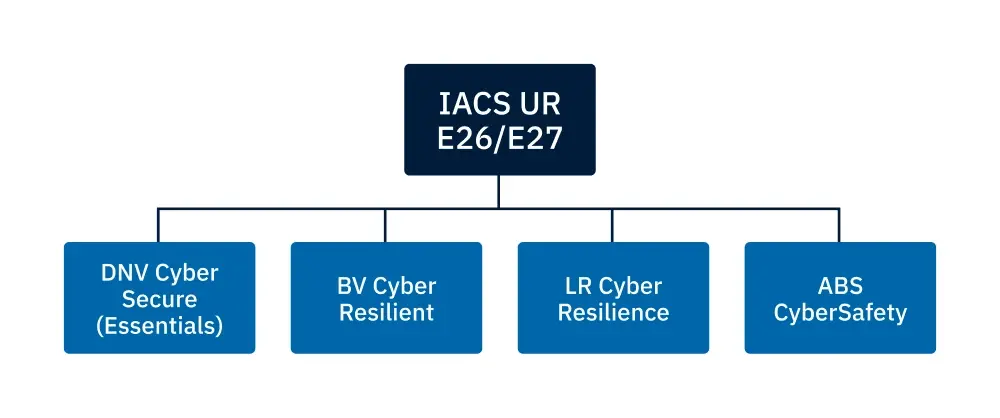like no other
We secure your bridge
Possibilities. Anywhere.
Enhancing maritime safety
with Operational Technology
Operational Technology (OT) – the systems that control and monitor physical processes – ensure safety and smooth operations on ships. From navigation systems, radar, Electronic Chart Display and Information Systems (ECDIS) to integrated bridge consoles, these systems form the backbone of vessel operations. As they become increasingly connected, they also face growing exposure to cyber threats.
Stay compliant with new cyber regulations.
Protect your vessel from rising cyber threats.
Cyber security is no longer optional, it’s a regulatory and operational necessity. Since July 2024, the International Association of Classification Societies (IACS) has mandated cyber security regulations for all new builds, while strongly encouraging voluntary compliance for existing vessels.
In 2024 alone, hundreds of successful attacks targeted legacy OT systems, impacting navigation and other mission-critical onboard functions. These incidents demonstrate how vulnerable vessels can be, if appropriate safeguards are not in place.
The new IACS requirements are designed to reduce the attack surface, contain infections, and ensure recovery to normal operating conditions with minimal downtime. By following these guidelines, you protect not only your commercial assets but also the safety of your crew and operations at sea.

IACS: Unified standards
for maritime cyber security
The International Association of Classification Societies (IACS) sets common rules that bring consistency to maritime cyber security. By harmonising requirements across class societies such as DNV, BV, Lloyd’s Register, and ABS, IACS ensures a unified regulatory approach that simplifies type approval and accelerates compliance processes.
This harmonisation is particularly important when addressing legacy systems, which often form critical functions onboard but may lack modern security features. Without proper network segmentation, security breaches can spread rapidly. The new mandatory regulations therefore place special focus on these vulnerable systems, how they interconnect, and how they are managed both onboard and remotely.
What is IACS?
IACS, the International Association of Classification Societies, unites the major players in the field—such as BV, DNV, ABS, Lloyd’s Register, Korean Register, ClassNK, and China Classification Society—to support regulators in setting minimum technical requirements.
For Telemar as a system integrator, this unified approach means streamlined type approval processes and smoother compliance across multiple flag administrations. Importantly, IACS has introduced UR E26 and UR E27, which create a dual-layered framework: vessel-wide governance combined with system-level resilience.
This framework ensures that ships are prepared to withstand cyber threats, remain compliant with evolving regulations, and operate securely in an increasingly connected maritime landscape.
Together, UR E26 and UR E27 create a dual-layered framework: vessel-wide governance combined with system-level resilience. This approach ensures that ships are prepared to withstand cyber threats, remain compliant with regulations, and operate securely in an increasingly connected maritime landscape.
Start your compliance journeyCyber resilience of ships
With many different systems onboard, UR E26 covers the cyber resilience of the vessel in its entirety. These requirements focus on the core principles of a cyber security plan as defined by the National Institute of Standards and Technology. Governance of this plan is of vital importance.
- Identify - Asset management. Know what is onboard and their risks.
- Protect - Implement measures to protect the assets.
- Detect - Abnormal behaviour, rapid detection of issues is key.
- Respond - Proceed with cyber security incident response plan.
- Recover - Return to normal operations with minimal downtime.
- Govern - Roles and responsibilities on ensuring effective cyber risk management.
Cyber resilience of onboard systems
To address multiple contractors and diverse technologies, UR E27 establishes cyber security requirements for each onboard system and product that falls within scope.
This regulation ensures that, at the point of delivery and acceptance, appropriate measures have been applied to secure every system. By requiring system-level cyber resilience from the outset, UR E27 ensures that onboard technologies do not become weak points that undermine the vessel’s overall compliance with UR E26.

Partner with us
for cyber resilience
You don’t have to face cyber security challenges alone. Telemar supports you from assessment and planning through to system integration and compliance, giving you peace of mind that your vessel is resilient, secure, and always prepared.
With Telemar, you benefit from:
- Clear guidance on navigating complex OT security requirements.
- Proven expertise in securing both IT and OT systems at sea.
- Smooth approval processes across class societies and flag administrations.
- Future-ready solutions that help you reduce risks, protect assets, and safeguard your crew.
Telemar supports your compliance journey.
Request a free consultationTalk to an expert
we're here to help
Simply fill out the form below, and our friendly team will get back to you promptly. We look forward to hearing from you!
